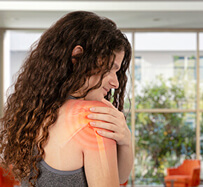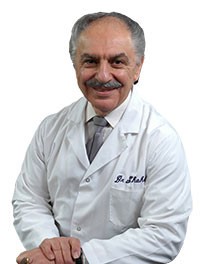Shoulder and Rotator Cuff Treatment in Midland Park, NJ

If pain, inflammation, and reduced mobility are making it difficult or impossible to move your arm and shoulder, you may have injured your shoulder or rotator cuff. This injury is common in patients whose occupation or hobby requires repetitive overhead arm motions. Desperate patients often turn to surgery.
The vast majority of rotator cuff patients, however, aren’t aware that often their surgery does not fully repair all of their damaged tissue – despite the pain relief and improved range-of-motion they feel. For a while. Long term outcomes aren’t so good when damaged tissue is left behind.
Regenerative medicine offers effective treatment of shoulder and rotator cuff damage via one of the most potent methods known to science: stem cell injection therapy. This advanced method may help repair your shoulder or rotator cuff without the need for costly surgeries or potentially dangerous medications.
To discuss treatment options for your shoulder or rotator cuff injury with a highly trained, compassionate provider in Midland Park today, call (201) 806-6099 or contact Dr. M. T. Shahab online.
What are the symptoms of shoulder or rotator cuff injury?
Repetitive overhead motions put stress on your shoulder and rotator cuff, straining the muscles and tendons and causing a dull, aching pain that may radiate down to your upper chest or back. This condition that develops slowly over time is called a degenerative tear. Symptoms of this condition include:
- difficulty sleeping due to pain
- arm weakness
- severely reduced range of arm motion
- difficulty reaching behind your back or over your head
While this injury is more common among people who do repetitive motions, a hard fall on your arm, lifting something heavy with a quick jerking motion, or a car accident injury can also damage your shoulder or rotator cuff. This type of injury happens quickly and is called an acute tear. Symptoms include:
- sudden pain in your upper arm or shoulder after impact or heavy lifting
- arm weakness that starts suddenly
- reduced range of arm motion
- difficulty reaching behind your back or over your head
If your pain started suddenly, call your medical provider or get emergency care right away.
How is shoulder and rotator cuff injury treated?
Unlike costly, time-consuming surgeries or risky medications, our stem cells may power up your body’s own restorative potential, minimizing or eliminating your pain and stimulating a natural healing response in your muscles and tendons.
Unlike surgery, which removes skin and bone, regenerative medicine focuses on using harvested live cells injected directly into your pain site. These stimulate your native cells to regenerate. Your provider will use live x-ray or ultrasound imaging for guidance, so the injection will be delivered precisely to your damaged cells.
Your injured cells bond with our stem cells, which may lead to regenerating your tissue and restoring your range of movement, allowing you to once again participate in your usual activities.
The live-nucleated cells injected by your provider may generate human growth factors for weeks, sometimes even months. How long they remain active depends on your age, body type, genetics, and type of injury. Treatment success also varies depending on these factors.
How do stem cells regenerate tissue?
When your tendons and joints are injured, their cells send out signals. Stem cells respond to those signals, flooding the injured tissue, releasing proteins that signal your native cells to begin regenerating.
Stem cells dock next to your cells and release:
- growth factors
- cytokine
- chemokines
These proteins then activate T-cells, opening up your blood vessels and form new ones. Then these cells leave your blood vessels and enter the surrounding tissues. This stimulates your cells to regenerate tissue, reduce inflammation, and regulate your immune system.
Where do these live stem cells come from?
We process the umbilical cord blood of healthy newborns. If a pregnant woman is not planning to keep her unborn child’s umbilical cord, she may choose to donate it. She’ll be asked to sign an informed consent form, followed by medical and social history reviews, as well as a blood test.
After a new mother meets all donor eligibility requirements and safely delivers her baby, the umbilical cord blood is collected in a sterile cord blood collection pouch and sent to a lab. The cord blood is processed within 48 hours using proprietary methods. A sample of the finished product is tested by an independent third-party lab for sterility. The umbilical cord stem cells are distributed once the lab reports have passed mandatory regulatory requirements.
Are umbilical cord stem cells FDA approved?
The FDA recently confirmed there is only one registered and approved stem cell product on the market: umbilical cord blood-derived hematopoietic progenitor cells (blood forming stem cells) used for certain indications. While there is enormous promise in stem cell therapies, and thousands of ongoing experiments trying to establish efficacy, stem cell treatments do not yet meet the FDA’s scientific approval standard.
Practitioners tapping into this enormous promise of stem cells for any therapeutic use must exercise their professional judgment and expertise. We urge anyone embarking on the use of stem cell therapies to consult the national health data bases to evaluate current clinical trial information, and the FDA’s website on human tissue to get its current therapy evaluations.
In 2018 the FDA’s commissioner and research director reported that the agency will be incorporating some “new concepts for how small investigators and firms can seek and meet the approval standard for products through efficient expedited pathways.” You can keep up with the latest developments on the FDA’s website.
How many cells does it take to treat my shoulder or rotator cuff?
20 years of scientific research and practice has provided us with proven treatment methods for many different types of injuries. After assessing your general health, your medical history, and your injury’s severity, your medical provider can make an informed judgment about how many million cells are needed for your specific condition.
Is it normal to have an inflammatory response after my injection?
Inflammatory responses after stem cell injections are common. It’s important to know that your body isn’t rejecting the cells and causing this response. In fact, this response may be a positive signal that the live cells are stimulating regeneration.
The level of your inflammatory response depends on:
- the levels of IL-6 within your joint or tissue
- the injury’s severity and level of your affected area’s inflammation
- whether PRP therapy was used along with stem cell injection, because this increases the probability of an inflammatory response
Will I be given an anesthetic?
A nominal amount of local anesthetic is given to numb the needle pathway on your skin. Your healthcare provider will not use a large amount of local anesthetic. Research shows doing so may damage the injected cells.
How long does it take to get relief?
Most patients report noticeable pain relief immediately after receiving their treatment. Your regeneration time varies depending on how severe your injury is, as well as whether you follow the recommended post-treatment care and physical therapy protocol.
Who can benefit from stem cell therapy?
If you’re seeking effective pain relief and healing without undergoing risky surgery or taking lots of medication, you’re probably a good candidate for stem cell injection. If you’ve experienced costly surgeries and taken prescription medication without getting much relief, then stem cell therapy may be the treatment that can help regenerate your damaged tissue.
Speak with a stem cell therapy specialist to discuss your current condition, medical condition, and treatment options in greater detail.
What are the risks or side effects of stem cell injections?
As with any other injection procedure, there’s a minor risk of bacterial infection not associated with the injected cells. If you experience severe pain, bleeding, or swelling at your injection site, or if you experience fever, nausea, dizziness, vomiting, or any other concerning symptoms, don’t wait—call your medical provider or seek emergency medical care right away.
Reserve Your Appointment Now
Our professional and compassionate providers have already aided a large number of patients in pain, helping them recover from their injuries and avoid dangerous surgeries and medications. Our medical professionals are happy to discuss your condition and create a stem cell treatment plan customized for your case.
To speak with a shoulder and rotator cuff stem cell specialist today in Midland Park, call (201) 806-6099 or contact Dr. M. T. Shahab online.
Standard disclaimer:
As with any medical procedure, results vary from patient to patient, depending on age, genetics, condition severity, as well as environmental and health factors. Consult your healthcare practitioner before embarking on your treatment journey.
MedWell Non Surgical Orthopedic Stem Cell & Regenerative Therapy Center
Address
33 Central AvenueMidland Park, NJ 07432
(201) 806-6099
www.BergenCountyDoctors.com
Hours
Mon:
8:00 am - 6:30 pm
Tue:
2:00 pm - 6:30 pm
Wed:
8:00 am - 6:30 pm
Thu:
9:00 am - 1:00 pm
Fri:
8:00 am - 6:30 pm
Sat:
9:00 am - 1:00 pm
Sun:
By Appointment Only




